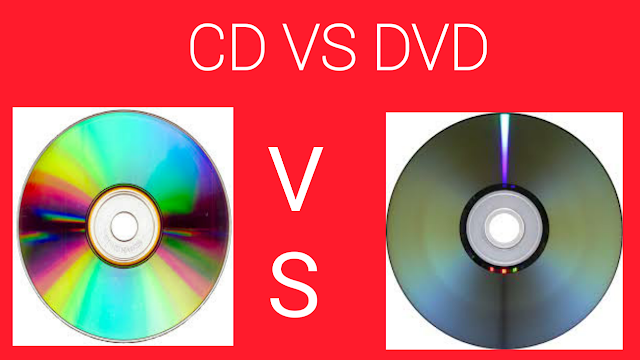CD and DVD are two different versions of an optical disk. These two versions of the optical disk are different from each other based on their sizes and manufacturing methods. Both CD and DVD work on optical technology and to retrieve the data from the CD and DVD, we use light especially from the laser. The data in the CD and DVD is stored in the form of bits and a laser beam is also connected in them. With the help of this laser beam, we can easily read the data which is stored in the CD and DVD. Here, we have explained the difference between CD and DVD.
What is the CD?
CD (Compact Disk) is the first step to storing information and data in the form of digital coding. To store data in the CD, we are using a novel method of coding. It means that we are using a 14-bit coding technique to store data and information on a CD. This 14-bit coding technique is also useful in detecting errors. After the development of the CD, it was accepted on a large scale. Its reason was that it was the low-priced method to store huge amounts of information in digital form.
What is a DVD?
DVD (Digital Versatile Disk) can also store information in digital form. The main quality of a DVD is that it can store information several times larger than a CD. A DVD can render videos with random access and better quality of the image. A DVD is also prepared from the same material as we are preparing the CD. Anyhow, the method and layers of these two discs are different. We can use the DVD from both sides. Therefore, we can say that two CDs are sticking together on a DVD. The main reason behind the larger space of a DVD is that it has dense packing of the bits, it has the shortest wavelength laser and we can store data on both sides.
Key Differences Between CD and DVD
CDs and DVDs are different from each other in various ways. Here, we have explained the key difference between CD and DVD.
♦ Capacity
The first main difference between a CD and a DVD is in their capacity. During the construction of the CD, it was the best replacement for cassette tapes. Nowadays, a CD can store 700 MB of data. For example, if you want to store audio content on a CD, its length should not exceed from 80 minutes. On the other hand, if you want to store video content on this disk, it should not exceed 60 minutes. A DVD is also known as an essential optical medium to store digital information and data. The capacity of a standard DVD is up to 4.7 GB. That’s why we are using a DVD to store large files like movies. The capacity of a CD and DVD is also the biggest difference between a CD and a DVD.
Relevant Post:
♦ Difference between Use of CD and DVD
Before the CD and DVD, we were using cassettes and VHS tapes for data storage. After that, the scientists introduced CDs. The main quality of the CD is that it can’t deteriorate the data even after playing it many times. That’s why it gained popularity and it replaced the cassettes and VHS tapes. Anyhow, due to the low storage capacity of this disk, we are using it to store software and computer programs. After some time, DVD was introduced. Due to the high compatibility and large storage of the DVD, we are using it to store large files like computer programs and movies. Moviemakers are using DVDs to store their data. As CD has low cost than DVD, that’s why we are using CDs instead of DVDs for music albums.
♦ Playback
Nowadays, we are using two kinds of players. The first is a CD player and the second is a DVD player. A CD player can run only a CD and it can’t run a DVD. On the other hand, a DVD player can run a DVD as well as a CD. As CD disks have lower costs than DVDs, we can run CDs in a DVD player too and we can store the entire music album on a CD, that’s why CDs are more useful for us than DVDs.
♦ Dual-Layer
A DVD is a dual-layer disk and a laser is equipped in a DVD to read the dual-layer. As we can store data on two layers of the DVD, that’s why a DVD has a large capacity than a CD. This dual-layer DVD is also helpful for us to retain the resolution and audio quality of the video. That’s why most Hollywood movies are produced using this technique. We are not using this technique in CDs. Moreover, CD players can’t read this dual-layer of the disks.
♦ Difference Between Formats of CD and DVD
A CD is available in just two formats. These two formats of the CDs are CD-R and CD-RW. On the other hand, there are more than half-dozen formats of DVDs available. Some essential formats of the DVDs are DVD-R, DVD+R, DVD-RAM, DVD+RW and DVD-RW, etc. The old DVD players can’t play all the formats of the DVDs. Anyhow, modern DVD players can easily play all the formats of DVDs as well as two formats of CDs.
♦ Difference Between Video Output of CD and DVD
All the DVD players have video outputs. It means that when we connect the DVD player to the television, it plays audio as well as video. On the other hand, a CD player doesn’t have a video output because it has only audio output. That’s why when you connect it to your television, it will run only audio and it will not run video.
♦ Purpose
The purpose of creating the CD and DVDs is also different. It means that a CD is created to store only audio and program files. On the other hand, a DVD is used to store a substantial amount of programs, movies, and other video files.
♦ Recording Layer
The recording layer is present both in the CDs and DVDs. The only difference is that in a CD, this recording layer is present close to the top of the disk. On the other hand, in the form of a DVD, this recording layer is present close to the middle of the disk.
♦ Pits
Layers of pits are also present both in CDs and DVDs but the only difference is that a CD has a single layer of the pits. On the other hand, a DVD has a double layer of pits.
♦ Space Between Loops and Pits
The space between the loops of a CD is 1.6mm and the space between the pits in a CD is 0.834mm. On the other hand, in the case of a DVD, the space between the loops is 0.74mm and the space between pits is 0.40mm.
♦ Error Correction Code
No doubt, there is a possibility of the occurrence of errors in a CD and a DVD. If an error occurs in a CD, we can use CIRC and EFMP as error corrections. On the other hand, if an error occurs in a DVD, we can use RS-PC and EFMPlus as error corrections.
♦ Data Transfer Rate
The data transfer rate on a DVD is greater than on a CD. It means that we can transfer data in a CD at the rate of 1.4 to 1.6 MB/sec and we can also transfer data in a DVD at the rate of 11MB/sec.
♦ Channel Bit Length
The channel bit length of a CD is 300 nm. On the other hand, the channel bit length of a DVD is 113 nm.
♦ Damage After the Removal of the Adhesive Labels
If we remove adhesive labels from a CD, it damages its metal layer only. On the other hand, if we remove adhesive labels from a DVD, it will become a cause of imbalance in the spin.
♦ Numeric Aperture and Thickness
The numeric aperture and thickness of a CD and a DVD are also different. The numeric aperture of CD is 0.45. On the other hand, the numeric aperture of a DVD is 0.6. Similarly, the thickness of a CD is 1.2 mm. On the other hand, the thickness of a DVD is 0.6 mm.
Conclusion
Both CD and DVD are known as optical recording mediums. Anyhow, a CD is the best medium to record the audio. On the other hand, a DVD is the best medium to store universal data. Due to the larger storage of a DVD, we can use it to store larger files. On the other hand, due to less storage capacity, we can use a CD to store only audio files and software. The formatting efficiency of a DVD is also 32% greater than the formatting efficiency of a CD.











2 thoughts on “Difference Between CD and DVD”